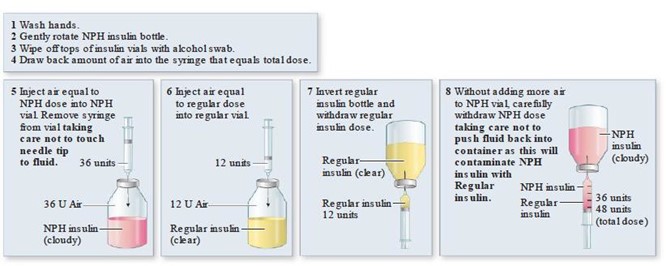A nurse is reinforcing teaching with a client who is to self-administer regular insulin and NPH insulin from the same syringe.
Which of the following instructions should the nurse provide?
Inject air into the regular insulin first.
Shake the NPH insulin until it is well mixed.
Draw up the NPH insulin into the syringe first.
Discard regular insulin if it appears cloudy.
The Correct Answer is A
“Inject air into the regular insulin first.” When mixing regular insulin and NPH insulin in the same syringe, the nurse should instruct the client to inject air into the NPH insulin vial first, then inject air into the regular insulin vial.
After that, the client should draw up the regular insulin into the syringe first, followed by the NPH insulin.
Choice B is not correct because NPH insulin should not be shaken vigorously as it can damage the insulin molecules.
Choice C is not correct because the regular insulin should be drawn up into the syringe first.
Choice D is not correct because regular insulin is a clear solution and should not appear cloudy.

Nursing Test Bank
Naxlex Comprehensive Predictor Exams
Related Questions
Correct Answer is A
Explanation
“Inject air into the regular insulin first.” When mixing regular insulin and NPH insulin in the same syringe, the nurse should instruct the client to inject air into the NPH insulin vial first, then inject air into the regular insulin vial.
After that, the client should draw up the regular insulin into the syringe first, followed by the NPH insulin.
Choice B is not correct because NPH insulin should not be shaken vigorously as it can damage the insulin molecules.
Choice C is not correct because the regular insulin should be drawn up into the syringe first.
Choice D is not correct because regular insulin is a clear solution and should not appear cloudy.

Correct Answer is ["94"]
Explanation
To calculate the flow rate in mL/hr, you need to divide the total volume to be infused by the total infusion time in hours (750 mL / 8 hr = 93.75 mL/hr).
Rounded to the nearest whole number, this is 94 mL/hr.
Whether you are a student looking to ace your exams or a practicing nurse seeking to enhance your expertise , our nursing education contents will empower you with the confidence and competence to make a difference in the lives of patients and become a respected leader in the healthcare field.
Visit Naxlex, invest in your future and unlock endless possibilities with our unparalleled nursing education contents today
Report Wrong Answer on the Current Question
Do you disagree with the answer? If yes, what is your expected answer? Explain.
Kindly be descriptive with the issue you are facing.
